Kuehne & Nagel International Bundle
How did Kuehne & Nagel conquer the global logistics landscape?
Journey back in time to discover the remarkable Kuehne & Nagel International SWOT Analysis and the fascinating Kuehne Nagel history. From its roots in 1890 Bremen, Germany, as a freight forwarding business, Kuehne & Nagel has evolved into a global powerhouse. This logistics company's story is one of strategic expansion, innovation, and a relentless pursuit of efficiency in the world of freight forwarding and supply chain solutions.
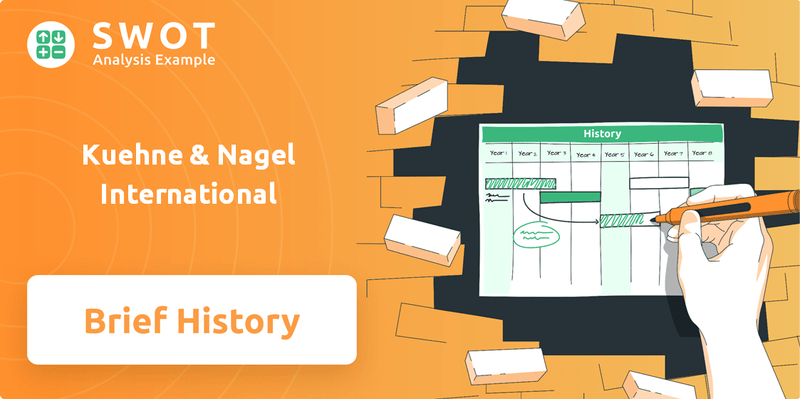
The story of Kuehne Nagel International is a compelling case study in business evolution. From its early years focused on cotton and consolidated freight, the company has consistently adapted to the changing demands of global trade. Understanding Kuehne Nagel's founding date and early strategic decisions provides valuable insights into its current global presence and its ability to offer comprehensive logistics services. This exploration of Kuehne Nagel's key milestones and major acquisitions reveals the drivers behind its impressive financial performance and industry impact.
What is the Kuehne & Nagel International Founding Story?
The story of Kuehne & Nagel, a leading global logistics company, began on July 1, 1890. This marked the official Kuehne Nagel founding date, when August Kuehne and Friedrich Nagel established their freight forwarding business in Bremen, Germany. Their combined expertise and vision laid the foundation for what would become a major player in the global supply chain solutions market.
Both founders brought valuable experience to the table. August Kuehne, born in 1855, had previously worked at Fr. Naumann, a forwarding company. He convinced Friedrich Nagel, a shipping agent born in 1864, to join him in this new venture. The initial capital invested was a modest 30,000 marks, a testament to their ambition and belief in the potential of their business idea.
The early years of Kuehne & Nagel were characterized by a focus on the burgeoning trade of the late 19th century. The company quickly identified opportunities in the handling of cotton and consolidated freight. This early focus on freight forwarding services, including pooling consignments, was crucial for optimizing transport efficiency. Even absorbing extra costs for partially filled railway cars was part of their strategy to meet delivery deadlines. The company also handled the forwarding of glassware. The name 'Kuehne & Nagel' has been retained, with Friedrich Nagel's legacy continuing even after his death in 1907, when August Kuehne took over his shares.
The business was founded in Bremen, Germany, with a focus on freight forwarding and commissioning services. Their initial capital was 30,000 marks.
- The company handled cotton and consolidated freight.
- They optimized transport efficiency by pooling consignments.
- The services included forwarding of glassware.
- August Kuehne took over Friedrich Nagel's shares in 1907.
For more insights into the ownership structure and the people behind the success of Kuehne & Nagel, you can explore the details in this article: Owners & Shareholders of Kuehne & Nagel International.
Kuehne & Nagel International SWOT Analysis
- Complete SWOT Breakdown
- Fully Customizable
- Editable in Excel & Word
- Professional Formatting
- Investor-Ready Format
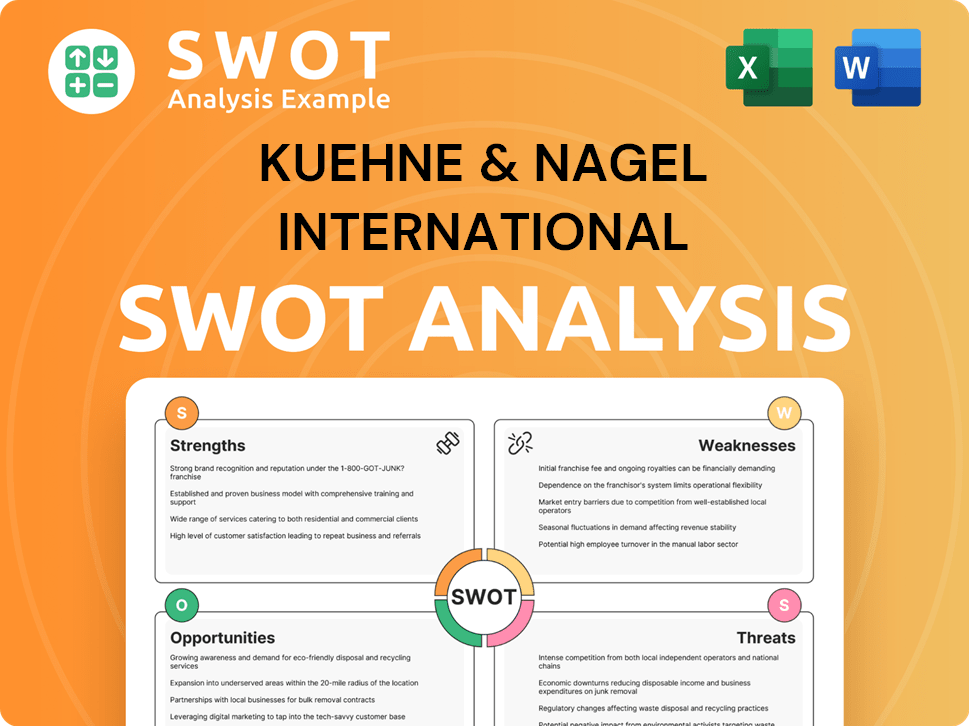
What Drove the Early Growth of Kuehne & Nagel International?
The early growth of Kuehne & Nagel was primarily focused within Germany, with expansion to Hamburg in 1902. The company navigated the challenges of World War I and later, after August Kuehne's passing in 1932, his sons took over. The post-war era brought significant opportunities for international expansion, marking a pivotal shift for the logistics company.
In the early 1950s, driven by concerns about the European political climate, Alfred Kuehne initiated the global outreach of Kuehne Nagel history. This led to the opening of the first foreign offices in Canada, followed by expansion into the Benelux region and the Middle East. This strategic move set the stage for Kuehne Nagel's future as a global leader in freight forwarding and supply chain solutions.
A key acquisition was the controlling stake in Proodos S.A. in Athens in 1963, followed by expansion into Italy. A significant structural change occurred in 1975 with the adoption of a holding company structure, establishing Kuehne Nagel International AG in Switzerland. These moves were crucial for streamlining operations and supporting further growth.
The mid-1960s saw Klaus-Michael Kuehne, a third-generation family member, join the company, driving further expansion, particularly in Europe and the Far East. This expansion strategy focused on building a worldwide network of offices and employing its own people to ensure higher service quality. This approach is further discussed in Growth Strategy of Kuehne & Nagel International.
In 1981, Lonrho Plc acquired a 50% stake in Kuehne & Nagel for DM 90 million, a move influenced by the Kuehne family's shipping fleet expansion losses. However, Kuehne & Nagel repurchased Lonrho's shares in 1992 and went public in 1994. This period marked a transition, solidifying the company's financial independence and setting the stage for further expansion in the global market.
Kuehne & Nagel International PESTLE Analysis
- Covers All 6 PESTLE Categories
- No Research Needed – Save Hours of Work
- Built by Experts, Trusted by Consultants
- Instant Download, Ready to Use
- 100% Editable, Fully Customizable
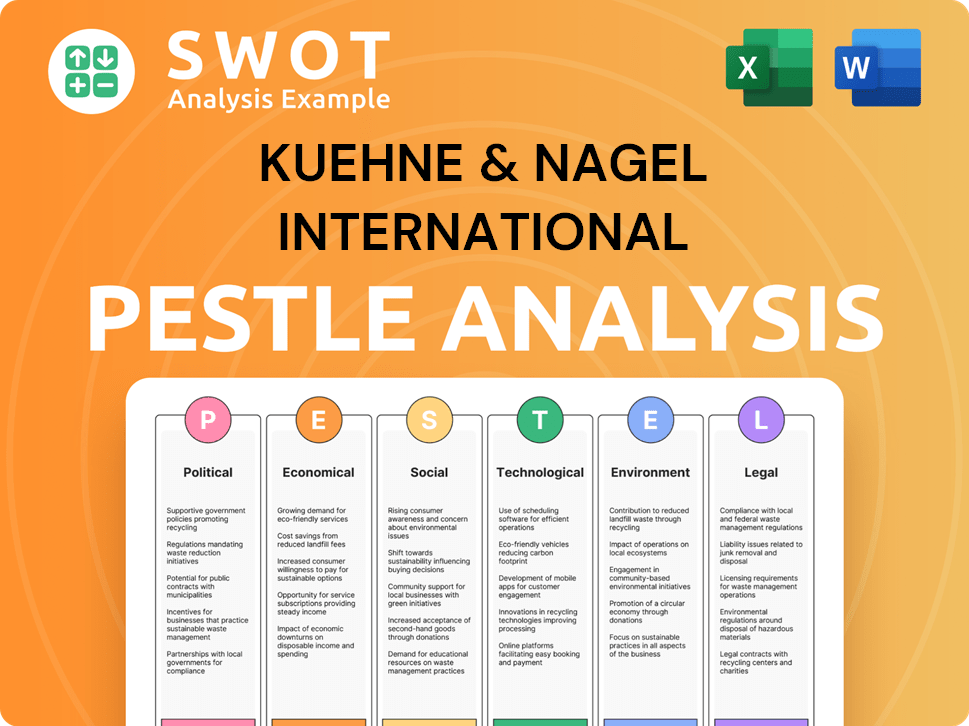
What are the key Milestones in Kuehne & Nagel International history?
The journey of Kuehne & Nagel (Kuehne Nagel) is marked by significant milestones, reflecting its evolution from a small freight forwarding business to a global logistics company. These achievements have shaped its position in the industry, demonstrating its adaptability and strategic vision. The Mission, Vision & Core Values of Kuehne & Nagel International have been instrumental in guiding the company through various phases of growth and transformation.
| Year | Milestone |
|---|---|
| 1890 | Founded in Bremen, Germany, by August Kühne and Friedrich Nagel, marking the beginning of Kuehne Nagel's operations. |
| 1950s | Internationalization of the company began under Alfred Kühne, expanding its reach beyond Germany. |
| 1960s-1970s | Klaus-Michael Kühne's leadership saw the establishment of a global network of offices, significantly increasing the company's global presence. |
| 2020 | Recognized as 'most visionary' in the Gartner Magic Quadrant for Third-Party Logistics Providers, highlighting its industry leadership. |
| 2023 | Launched the Roadmap 2026 strategy, focusing on digital platforms, technology, and sustainability initiatives. |
| 2024 | Acquired a 51% stake in IMC Logistics in November, fully owning it in early 2025, expanding its U.S. presence. |
| 2024 | Acquired Farrow, a customs broker in Canada, and City Zone Express in Southeast Asia, to enhance its service offerings. |
| 2025 | Launched a carrier engagement sustainability program, signing MoUs with 14 global airline carriers to reduce airfreight emissions. |
Innovation has been a cornerstone of Kuehne & Nagel's strategy, particularly in developing IT-based, industry-specific logistics solutions. These advancements have been crucial in maintaining its competitive edge and adapting to the evolving demands of the supply chain solutions sector.
Development of IT-based logistics solutions tailored to specific industries has been a key innovation. This has enabled Kuehne & Nagel to offer more efficient and customized services.
The introduction of the Network Transportation Management (NTM) Optimizer has enhanced operational efficiency. This tool helps optimize transportation networks, leading to better resource allocation.
The Factory Management module provides enhanced control and visibility over manufacturing processes. This module improves coordination and reduces delays.
Increased transaction volumes with the Infor Nexus platform have streamlined operations. This platform facilitates better communication and data sharing.
Enhancements to digital platforms are a key focus of the Roadmap 2026 strategy. These platforms are designed to improve customer experience and operational efficiency.
Investments in emission transparency and low-carbon fuels demonstrate a commitment to sustainability. These initiatives aim to reduce the environmental impact of its operations.
Despite its successes, Kuehne & Nagel has faced several challenges throughout its history. These obstacles have tested its resilience and required strategic adaptations to maintain its position in the competitive freight forwarding industry. Economic downturns and the complexities of global trade continue to present ongoing challenges for the logistics company.
The First World War brought the business to a near standstill, significantly disrupting operations. This period highlighted the vulnerability of the company to global events.
The destruction of its headquarters in Bremen during an air raid in 1944 was a major setback. The company also faced ethical challenges during this period.
In Q1 2025, the Road Logistics segment experienced a 37% drop in EBIT due to weak demand in European markets. This led to reduced capacity utilization.
Economic downturns pose ongoing challenges, affecting demand and profitability. The company must adapt to changing market conditions.
The logistics industry is highly competitive, requiring continuous innovation and efficiency improvements. Kuehne Nagel faces pressure from various competitors.
Achieving sustainability goals, such as reducing GHG emissions by 33% by 2030, requires significant investment and operational changes. This is a long-term challenge.
Kuehne & Nagel International Business Model Canvas
- Complete 9-Block Business Model Canvas
- Effortlessly Communicate Your Business Strategy
- Investor-Ready BMC Format
- 100% Editable and Customizable
- Clear and Structured Layout
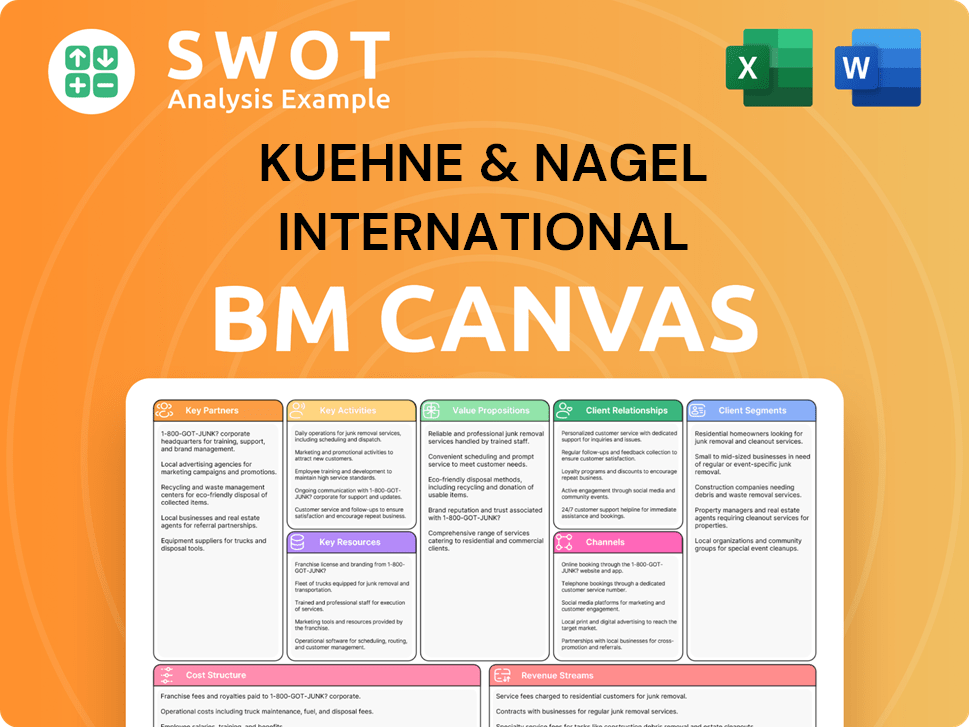
What is the Timeline of Key Events for Kuehne & Nagel International?
The Kuehne Nagel history is marked by significant milestones, from its founding in 1890 as a forwarding agency to its current status as a leading global logistics company. The company's evolution includes strategic expansions, acquisitions, and a strong focus on digital transformation and sustainability. Kuehne & Nagel International has navigated various economic landscapes, consistently adapting to meet the changing demands of the freight forwarding and supply chain solutions industry.
| Year | Key Event |
|---|---|
| 1890 | August Kuehne and Friedrich Nagel founded Kuehne + Nagel in Bremen, Germany. |
| 1902 | Operations expanded to Hamburg, Germany. |
| 1907 | Co-founder Friedrich Nagel died; August Kuehne took over his shares. |
| 1932 | August Kuehne died; sons Alfred and Werner became joint partners. |
| 1950s | Alfred Kuehne initiated international expansion, opening offices in Canada, Benelux, and the Middle East. |
| 1960s | Klaus-Michael Kuehne joined the company and spearheaded global network expansion. |
| 1975 | The company adopted a holding company structure, forming Kuehne+Nagel International AG in Switzerland. |
| 1981 | Lonrho Plc acquired a 50% stake in Kuehne+Nagel. |
| 1992 | Kuehne+Nagel repurchased Lonrho's shares. |
| 1994 | Kuehne+Nagel went public. |
| 2001 | Acquired USCO Logistics Inc. |
| 2020 | Recognized as 'most visionary' in the Gartner Magic Quadrant for Third-Party Logistics Providers. |
| March 2023 | Introduced Roadmap 2026 strategy, focusing on digital transformation, sustainability, and market potential. |
| November 2023 | Acquired Farrow, a customs broker in Canada, with full ownership in early 2024. |
| June 2024 | Became the logistics partner for the British Olympic Association for the 2024 Summer Olympics in Paris. |
| September 2024 | Opened a highly automated fulfillment center for Adidas in Mantova, Italy, spanning 130,000 sqm. |
| November 2024 | Strengthened U.S. presence with the acquisition of a 51% stake in IMC Logistics. |
| December 2024 | Reported a net turnover of CHF 24.8 billion for 2024, a 4% increase year-on-year, with EBIT of CHF 1.7 billion and earnings of CHF 1.2 billion. |
| Q1 2025 | Reported a 15% increase in net turnover to CHF 6.3 billion (Q1 2025 vs Q1 2024), EBIT up 7% to CHF 402 million, and earnings up 9% to CHF 303 million, driven by market share gains in Sea and Air Logistics. |
| May 2025 | Launched a carrier engagement sustainability program, signing MoUs with 14 global airline carriers to reduce air freight emissions. |
Kuehne & Nagel's 'Vision 2030' aims to become the most trusted supply chain partner, supporting a sustainable future. This involves growth at 1.5 times the global GDP growth rate through 2030, and a focus on digital platforms and technological advancements to improve logistics solutions.
The 'Roadmap 2026' is the strategic plan built on four cornerstones: Kuehne+Nagel Experience, Digital Ecosystem, Living ESG, and Market Potential. The company targets a conversion rate for Sea and Air Logistics of approximately 35% through 2030, emphasizing customer experience and digital transformation.
Kuehne Nagel is committed to sustainability, targeting 100% renewable energy consumption at its contract logistics sites and 30% on-site renewable electricity production by 2030. The company aims for zero-emission vehicles to comprise 60% of its truck fleet by 2030, reducing its environmental footprint.
Despite market uncertainties, Kuehne & Nagel maintains its full-year recurring EBIT guidance for 2025 between CHF 1.5 billion and CHF 1.75 billion. The company's Q1 2025 results show a 15% increase in net turnover to CHF 6.3 billion, with EBIT up 7% to CHF 402 million, demonstrating strong financial performance.
Kuehne & Nagel International Porter's Five Forces Analysis
- Covers All 5 Competitive Forces in Detail
- Structured for Consultants, Students, and Founders
- 100% Editable in Microsoft Word & Excel
- Instant Digital Download – Use Immediately
- Compatible with Mac & PC – Fully Unlocked
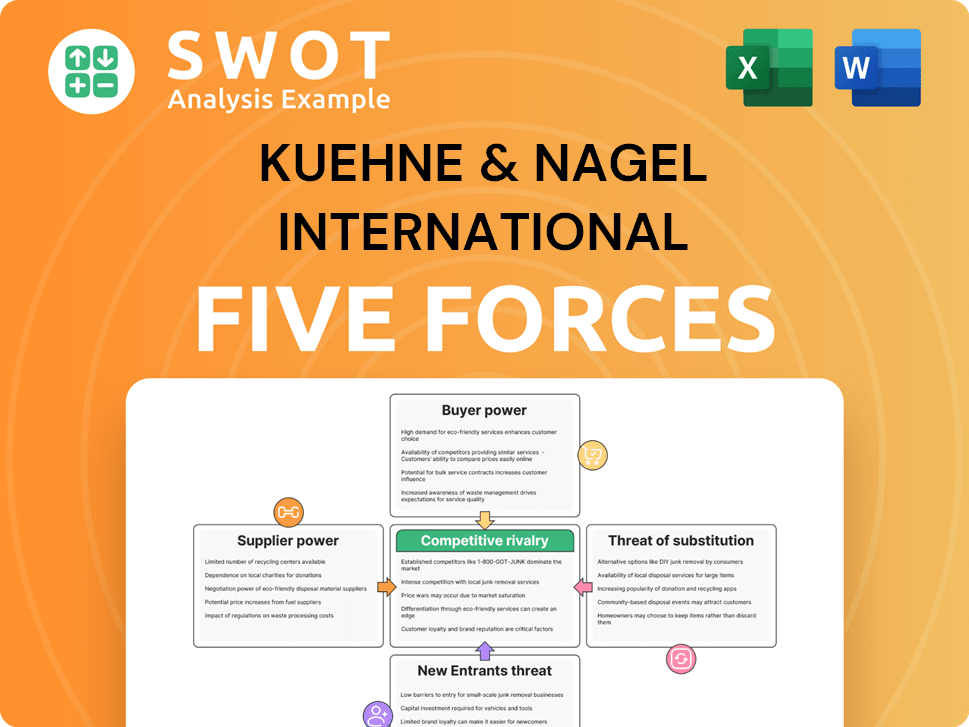
Related Blogs
- What is Competitive Landscape of Kuehne & Nagel International Company?
- What is Growth Strategy and Future Prospects of Kuehne & Nagel International Company?
- How Does Kuehne & Nagel International Company Work?
- What is Sales and Marketing Strategy of Kuehne & Nagel International Company?
- What is Brief History of Kuehne & Nagel International Company?
- Who Owns Kuehne & Nagel International Company?
- What is Customer Demographics and Target Market of Kuehne & Nagel International Company?
Disclaimer
All information, articles, and product details provided on this website are for general informational and educational purposes only. We do not claim any ownership over, nor do we intend to infringe upon, any trademarks, copyrights, logos, brand names, or other intellectual property mentioned or depicted on this site. Such intellectual property remains the property of its respective owners, and any references here are made solely for identification or informational purposes, without implying any affiliation, endorsement, or partnership.
We make no representations or warranties, express or implied, regarding the accuracy, completeness, or suitability of any content or products presented. Nothing on this website should be construed as legal, tax, investment, financial, medical, or other professional advice. In addition, no part of this site—including articles or product references—constitutes a solicitation, recommendation, endorsement, advertisement, or offer to buy or sell any securities, franchises, or other financial instruments, particularly in jurisdictions where such activity would be unlawful.
All content is of a general nature and may not address the specific circumstances of any individual or entity. It is not a substitute for professional advice or services. Any actions you take based on the information provided here are strictly at your own risk. You accept full responsibility for any decisions or outcomes arising from your use of this website and agree to release us from any liability in connection with your use of, or reliance upon, the content or products found herein.